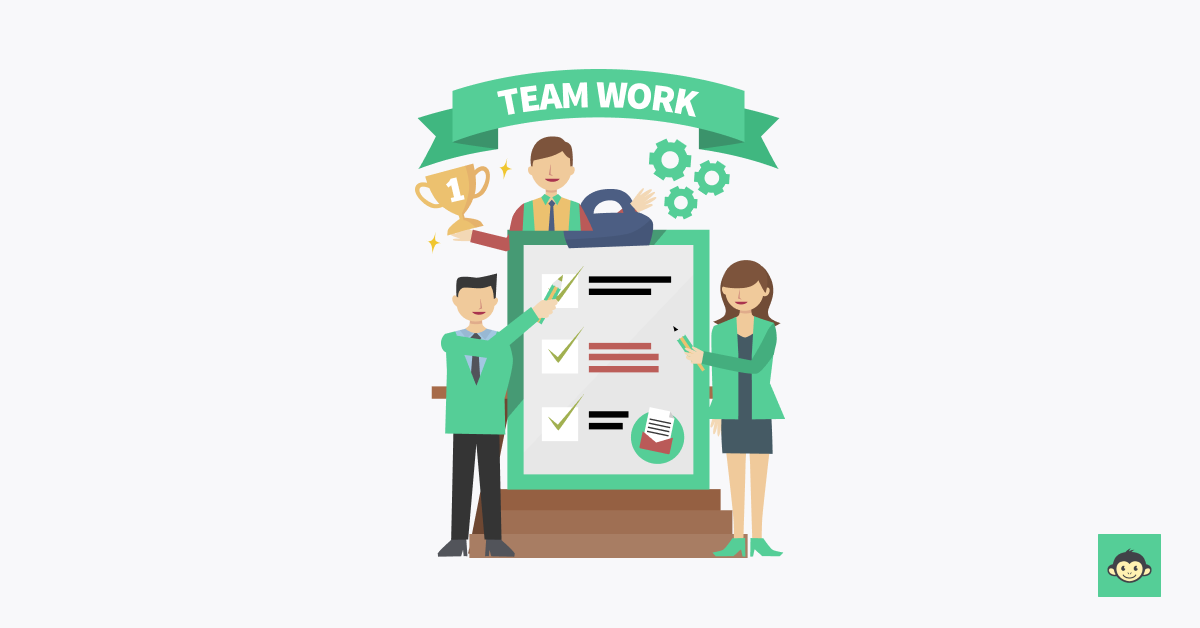What is an employee engagement survey template?

Have you ever wondered what makes some workplaces thrive with productivity and creativity while others seem stuck in a never-ending cycle of disengagement? Well, the secret ingredient could very well be employee engagement surveys! Today, we're diving into the wonderful world of the employee engagement surveys and why they hold the key to unlocking the full potential of your workforce.
Imagine this: You stroll into your favorite coffee shop, eager for your daily dose of caffeine. The barista greets you with a smile, takes your order, and genuinely asks how your day is going. You feel valued and important, right?
Now, picture the opposite scenario, where the barista robotically takes your order without a hint of interest. The difference in your experience is stark, and it all boils down to engagement—the barista's level of connection with you as a customer.
Just like in the coffee shop, employee engagement surveys allow organizations to gauge the level of connection and enthusiasm their employees have for their work. These surveys act as a window into the hearts and minds of the workforce, providing valuable insights into their motivations, concerns, and ideas for improvement.
By actively involving employees in the decision-making process, organizations can create a sense of ownership, boost morale, and foster a culture of trust and collaboration.
To better understand the significance of these engagement surveys, think about it this way: they're like an x-ray machine that helps diagnose the health of your organization.
They help you identify areas that need attention, whether it's communication gaps, leadership issues, or workflow bottlenecks. Armed with this knowledge, you can implement targeted strategies to enhance employee satisfaction, productivity, and retention.
Now that we've got your attention let's dig deeper into the world of engagement surveys and explore how they can transform your workplace into a thriving hub of happy and motivated individuals. Get ready to unlock the secret sauce for employee engagement!
Table of contents:-
- What are employee surveys?
- What is the importance of measuring employee engagement?
- How often should you conduct employee engagement surveys?
- What is an employee engagement survey template?
- How are good employee engagement survey templates structured?
- 10 Best practices in conducting employee engagement surveys
- Types of employee engagement survey templates
- Key employee engagement drivers to keep in mind while measuring employee engagement
- Importance of an employee engagement survey tool to measure employee engagement
- How can you improve and sustain employee engagement based on engagement survey results?
What are employee surveys?

Employee surveys are like a compass that helps organizations navigate the vast sea of employee sentiment and satisfaction. They are specially designed questionnaires that capture the thoughts, opinions, and experiences of employees regarding their work environment, job satisfaction, leadership, and overall contentment.
Think of it as a friendly conversation with your team members, where you ask them thought-provoking questions to understand their perspectives. These surveys can cover a wide range of topics, from the effectiveness of communication channels to the availability of growth opportunities, from work-life balance to recognition and rewards.
The goal is to gather comprehensive feedback that sheds light on the factors that drive engagement and those that may hinder it.
Now, you might be wondering how these surveys actually work. Well, typically, they are distributed electronically, making it easy for employees to respond at their convenience.
These anonymous surveys allow individuals to express their thoughts freely without fear of repercussions. This anonymity fosters honesty and encourages employees to share their true feelings, resulting in more accurate data.
The power of employee surveys lies in their ability to provide organizations with a holistic view of the employee's experience. By analyzing the survey responses, employers can identify trends, patterns, and areas of improvement.
For example, if the majority of employees express dissatisfaction with the current performance evaluation process, the organization can take proactive steps to revamp it, leading to greater satisfaction and development.
Ultimately, employee surveys are not just about collecting data. They are about fostering a culture of open communication, trust, and collaboration. When employees see that their opinions matter and their voices are heard, they become more engaged and invested in the success of the organization. It's a win-win situation for everyone involved!
So, buckle up as we embark on a journey to discover how employee surveys can revolutionize how you perceive and nurture your workforce. Get ready to unlock the secrets of team satisfaction and take your organization to new heights of success!
What is the importance of measuring employee engagement?

Measuring engagement is crucial for several reasons.
First and foremost, it provides organizations with valuable insights into the overall health and happiness of their workforce. Just like a doctor monitors vital signs to assess a patient's well-being, measuring engagement allows you to gauge the pulse of your organization.
It helps you identify areas of strength and areas that need improvement, enabling you to take targeted actions to enhance workplace satisfaction, motivation, and productivity.
Moreover, it demonstrates that you value your employees' opinions and experiences. It shows that you care about creating a positive work environment where employees feel heard, appreciated, and engaged.
When employees see that their voices matter, they are more likely to be loyal, committed, and willing to go the extra mile for the organization's success.
How often should you conduct employee engagement surveys?

As for the frequency of conducting employee surveys, it's a bit like tending to a garden. You want to strike the right balance between keeping a finger on the pulse and not overwhelming your employees with constant surveys. The ideal frequency can vary depending on the organization's size, industry, and culture.
In general, companies perform annual engagement surveys. It allows for a comprehensive review of the overall employee experience, tracking progress over time and identifying long-term trends.
However, keep in mind that a lot can happen in a year, so supplementing annual surveys with occasional employee pulse surveys can help capture real-time insights and address emerging issues promptly.
Remember, the goal is not just to check a box but to foster continuous improvement. By regularly measuring engagement, you can stay attuned to the evolving needs and concerns of your workforce, adapting your strategies and initiatives accordingly.
It's like having your finger on the organization's pulse, ensuring it beats with vitality and energy.
So whether it's an annual survey, pulse surveys, or a combination of both, the key is to make measuring engagement an ongoing commitment
What is an employee engagement survey template?

An employee engagement survey template is like a ready-made blueprint for conducting an effective and insightful survey. It's a pre-designed set of employee engagement survey questions and response options that organizations can use as a foundation for their employee survey.
These templates provide a framework to ensure that essential aspects of engagement are covered while still allowing room for customization to meet the unique needs of each organization.
Think of it as a recipe for success. Just as a recipe outlines the ingredients and steps to create a delicious dish, a survey template outlines the employee engagement questions and areas of inquiry to gather valuable data on workplace satisfaction, motivation, and overall contentment.
These templates save you time and effort, as they are crafted based on best practices and research, ensuring that you ask the right questions to uncover meaningful insights.
How are good employee engagement survey templates structured?

The structure of a good employee survey template is like a well-organized roadmap, guiding you through the labyrinth of employee sentiments and experiences. While specific templates may vary, they generally follow a structured format designed to capture comprehensive feedback. Here are some key elements you'll typically find in a well-structured template:
Introduction
A warm and inviting welcome sets the tone for the survey, explaining its purpose and reassuring employees that their input is valued.
Demographic information
It's important to gather some basic demographic data (e.g., job role, department, tenure) to understand how different factors may impact the engagement of employees.
Core engagement questions
These are the heart and soul of the survey, probing into key areas such as job satisfaction, communication, leadership, teamwork, and opportunities for growth. Open-ended and multiple-choice questions are often used to gather both qualitative and quantitative data.
Additional focus areas
Depending on the organization's specific priorities, the template may include sections dedicated to topics like diversity and inclusion, work-life balance, or organizational culture.
Likert scale ratings
A popular feature in every employee survey is the Likert scale, where employees rate their level of agreement or satisfaction on a scale (e.g., 1 to 5) for a series of statements. This provides a standardized way to measure and compare responses.
Comment boxes
Giving employees the space to share their thoughts, suggestions, and concerns through comment boxes allows for more detailed feedback and uncovers valuable insights that may not be captured by predefined survey questions.
Conclusion
A heartfelt thank-you message and a clear explanation of the next steps demonstrate appreciation for employees' participation and emphasize the organization's commitment to taking action based on the survey results.
The beauty of a good survey template lies in its balance of structure and flexibility. It provides a solid foundation while allowing organizations to tailor the survey to their specific needs, ensuring a comprehensive exploration of engagement as a concept and paving the way for positive cha
10 Best practices in conducting employee engagement surveys

Clearly define survey objectives
Before diving into survey design, establish clear goals and objectives. Determine what specific insights you want to gather, such as identifying areas of improvement, measuring workplace satisfaction, or assessing the impact of recent changes.
Ensure confidentiality and anonymity
Create a safe space for employees to express their opinions honestly. Assure them that their responses will remain confidential and anonymous. This fosters trust and encourages employees to provide candid feedback.
Keep it concise
Respect your employees' time and attention by keeping the survey concise and focused. Long surveys can lead to survey fatigue and lower response rates. Include only the essential employee engagement survey questions that align with your objectives.
Use a mix of employee engagement survey questions
Employ a variety of employee engagement survey questions to gather comprehensive data and collect employee feedback. Use closed-ended questions with response scales, as well as open-ended questions, to allow for qualitative insights. This combination provides a well-rounded view of employee sentiments.
Use clear and simple language
Opt for clear and simple language in your survey questions. Avoid jargon or complex terminology that may confuse respondents. Ensure that questions are easy to understand and answer accurately.
Include benchmarking questions
To gain a broader perspective, include benchmarking questions that allow you to compare your organization's results to industry standards or past surveys. This helps identify areas where your organization excels or needs improvement.
Provide context and instructions
Offer context and instructions for each section of the survey. Clearly explain the purpose of the employee engagement questions and provide any necessary guidelines to ensure accurate and consistent responses.
Consider timing and frequency
Choose an appropriate time to administer the survey, considering factors like workload, organizational changes, or seasonal variations. Regularly assess the frequency of your surveys to strike a balance between staying informed and avoiding survey fatigue.
Communicate survey results and actions taken
Once the survey is complete, communicate the results to employees. Share key findings, highlight areas for improvement, and outline actions that will be taken based on the feedback received. This demonstrates transparency and reinforces the value of employee input.
Follow up and track progress
These surveys should not be a one-off event. Regularly follow up with employees to discuss progress made on identified issues and to track improvements. This iterative process demonstrates that feedback is acted upon and helps sustain a culture of continuous improvement.
Types of employee engagement survey templates

Let’s explore a range of employee survey templates, each designed to address specific areas of employee experience, satisfaction, and overall contentment
From measuring employee benefits and motivation to assessing attitudes, well-being, and training effectiveness, these templates offer a structured approach to gathering valuable feedback.
Employee benefits survey template
This template focuses specifically on evaluating employee satisfaction with the benefits and perks provided by the organization. It aims to gather feedback on the effectiveness, relevance, and value of the benefits package.
Employee engagement survey template
This is a comprehensive survey that assesses overall employee engagement levels. It covers various aspects such as job satisfaction, communication, leadership, work-life balance, growth opportunities, and organizational culture.
Employee motivation survey template
This template explores factors that drive employee motivation and engagement. It delves into aspects like recognition, rewards, career advancement, personal development opportunities, and alignment with organizational goals.
Employee opinion survey template
The employee opinion survey template is designed to gather employees' opinions on specific topics or initiatives within the organization. It seeks to understand employee perspectives, attitudes, and suggestions for improvement.
Employee pulse survey template
Pulse surveys are short, frequent surveys conducted at regular intervals to capture real-time employee feedback on specific issues. These surveys provide a quick pulse check on employee engagement levels and help identify emerging concerns.
Employee experience survey template
This template focuses on understanding the overall employee experience throughout their journey with the organization. It covers aspects like recruitment, onboarding, development, performance management, and offboarding.
Employee feedback survey template
The employee feedback survey template aims to gather feedback on various aspects of the work environment, processes, and policies. It encourages employees to provide suggestions, ideas, and constructive criticism for continuous improvement.
Employee onboarding survey template
This template assesses the effectiveness of the onboarding process and gathers feedback from new hires. It aims to understand their experience, integration into the organization, and the support provided during the onboarding period.
Employee exit survey template
The exit survey template gathers feedback from employees who are leaving the organization. It aims to understand the reasons for their departure, gather insights to improve retention, and identify potential areas of improvement.
Employee training survey template
This template focuses on evaluating the effectiveness of training programs provided to employees. It assesses the relevance, quality, and impact of the training initiatives on employee skills, knowledge, and performance.
Employee performance survey template
This template gathers feedback on the performance management process. It seeks to understand employees' perceptions of goal setting, feedback, performance evaluations, and career development discussions.
Employee attitude survey template
This employee engagement question template explores employees' attitudes, opinions, and feelings towards various aspects of the workplace, such as the culture, leadership, teamwork, and job satisfaction.
Employee happiness survey template
This template measures employee happiness and overall well-being within the organization. It assesses factors like work-life balance, job satisfaction, relationships with colleagues, and opportunities for personal growth.
Employee recognition survey template
This template focuses on assessing the effectiveness of employee recognition programs and initiatives. It seeks feedback on the frequency, types, and impact of recognition received by employees.
Employee mental health survey template:
This template focuses on assessing employees' mental health and well-being within the workplace. It explores stress levels, work-life balance, support systems, and the organization's efforts in promoting mental well-being.
Employee satisfaction survey template
The employee satisfaction survey template evaluates overall employee satisfaction levels. It covers many aspects, including job satisfaction, work environment, compensation, benefits, and career development.
Employee safety perception survey template
This template assesses employees' perceptions of safety within the workplace. It gathers feedback on aspects such as safety protocols, training, equipment, and overall safety culture. It aims to identify areas of improvement and ensure a safe working environment for employees.
Diversity and inclusion survey template
This template focuses on evaluating employees' experiences and perceptions related to diversity and inclusion within the organization. It assesses factors such as inclusivity, equity, representation, and opportunities for diverse voices to be heard.
These various types of employee engagement survey templates allow organizations to delve deeper into specific areas of employee experience and gather targeted feedback. By using these templates, organizations can gain valuable insights, identify strengths and weaknesses, and make informed decisions to enhance employee engagement, satisfaction, and overall organizational success.
Key employee engagement drivers to keep in mind while measuring employee engagement

Measuring employee engagement is not just about administering surveys; it's about understanding the factors that drive engagement and using that knowledge to create a more positive and fulfilling work environment.
When conducting an employee survey, it's essential to keep in mind the key drivers that have a significant impact on employee engagement. Let's explore some of these drivers:
Effective communication
Open and transparent communication is a vital driver of employee engagement. Employees need to feel informed, heard, and connected to the organization's goals, strategies, and updates. Regular communication channels, feedback mechanisms, and opportunities for dialogue contribute to a sense of belonging and engagement.
Leadership and management
Strong leadership and effective management practices are crucial for employee engagement. Supportive leaders who provide clear direction, empower employees, and foster a positive work culture have a significant impact on engagement levels.
Managers who offer guidance, recognition, and growth opportunities help employees feel valued and motivated.
Recognition and appreciation
Recognizing and appreciating employees' efforts and achievements is a powerful driver of engagement. Acknowledging employees' contributions through formal and informal recognition programs, rewards, and expressions of gratitude can significantly boost morale and motivation.
Career development and growth
Opportunities for professional development and career advancement are essential for employee engagement. When employees see a clear path for growth, receive training and mentoring, and have opportunities to enhance their skills, they feel valued and motivated to invest in their work.
Work-life balance
Striking a healthy work-life balance is crucial for employee well-being and engagement. Organizations that prioritize work-life balance by offering flexible schedules, remote work options, and supportive policies promote a sense of harmony, reducing stress and enhancing engagement.
Inclusive and diverse culture
A culture that embraces diversity and inclusivity fosters employee engagement. Organizations that create an environment where everyone feels valued, respected, and empowered regardless of their background, race, gender, or identity tend to have higher engagement levels.
Employee well-being
Promoting employee well-being, both physical and mental, is an important driver of engagement. Providing resources, support, and wellness programs demonstrates a commitment to employees' holistic health and contributes to a positive work environment.
Autonomy and empowerment
Granting employees autonomy and decision-making authority within their roles can increase engagement. Empowered employees feel trusted, capable, and motivated to take ownership of their work, leading to higher levels of engagement.
Team collaboration
Encouraging collaboration and fostering a sense of teamwork among employees can drive engagement. When employees feel connected to their colleagues, and have opportunities for collaboration and mutual support, it boosts engagement and overall job satisfaction.
Organizational values and purpose
Aligning employees with the organization's values and purpose is a significant driver of engagement. When employees understand and connect with the larger mission, vision, and values of the organization, they find meaning in their work, leading to increased engagement.
By considering these key drivers when designing and analyzing an employee survey, organizations can gain valuable insights into areas that require attention and improvement.
It allows organizations to take targeted actions to enhance engagement levels and create a workplace that fosters satisfaction, productivity, and growth. So, let's keep these drivers in mind as we dive into the realm of measuring engagement and unlocking the full potential of your workforce.
Importance of an employee engagement survey tool to measure employee engagement

Employee engagement is not something that can be accurately assessed through guesswork or assumptions. It requires a systematic and data-driven approach. That's where an engagement survey tool comes into play.
This powerful tool enables organizations to gather valuable feedback, measure engagement levels, and identify areas for improvement. Let's explore the importance of using an engagement survey tool:
Objective measurement
An employee engagement survey tool provides a standardized and objective way to measure employee engagement. It offers a structured questionnaire and data collection process, ensuring consistency and reliability in the results. This allows organizations to obtain accurate insights into employee perceptions and experiences.
Identifying strengths and weaknesses
By using an engagement survey tool, organizations can identify the specific areas where they excel and the areas that require improvement. It helps pinpoint strengths that can be leveraged and weaknesses that need attention. With this information, organizations can develop targeted strategies to enhance engagement.
Employee feedback and participation
An engagement survey tool allows employees to voice their opinions and concerns. It creates a platform for employees to share their thoughts openly and anonymously, promoting a culture of transparency and trust. Employees feel valued and involved when their feedback is actively sought, leading to increased engagement.
Data-driven decision-making
An engagement survey tool generates insightful data that organizations can analyze and use to make informed decisions. It provides quantitative and qualitative data to guide leaders and managers in developing effective engagement initiatives. By relying on data rather than assumptions, organizations can implement evidence-based strategies for improvement.
Monitoring progress over time
An engagement survey tool enables organizations to track engagement levels over time. By conducting regular surveys, organizations can monitor progress, identify trends, and evaluate the impact of interventions.
This helps in creating a continuous feedback loop and places emphasis on organizations placing focus on the need to measure engagement.
Benchmarking and comparison
An engagement survey tool often provides benchmarking capabilities, allowing organizations to compare their engagement levels with industry standards or other similar organizations. Benchmarking provides insights into how the organization fares in relation to others, highlighting areas of strength and areas that need improvement.
Enhancing communication and trust
The act of conducting an engagement survey using a dedicated tool itself communicates to employees that their opinions matter and that the organization is committed to their well-being. This fosters a sense of trust and strengthens the employee-employer relationship.
How can you improve and sustain employee engagement based on engagement survey results?

Based on the survey results, identify areas where employees seek growth and development. Offer relevant training programs, mentoring, and opportunities for skill enhancement. This shows a commitment to employee growth and enhances engagement.
Once the engagement survey results are collected and analyzed, the real work begins – taking action to improve and sustain employee engagement. Here are some strategies to consider:
Act on feedback
Actively address the feedback provided in the engagement survey. Identify key areas for improvement and develop action plans to address specific concerns. Communicate the steps being taken to address the feedback, demonstrating that employee input is valued and acted upon.
Set clear goals
Based on the survey results, set clear and measurable goals to improve employee engagement. Define specific objectives and milestones that align with the survey findings. This provides a roadmap for progress and ensures accountability.
Involve employees
Involve employees in the process of improving engagement. Encourage them to contribute ideas, suggestions, and solutions. This empowers employees and fosters a sense of ownership and commitment to the improvement initiatives.
Enhance communication
Strengthen communication channels and practices within the organization. Foster open and transparent communication between leaders, managers, and employees. Regularly share updates, progress, and successes related to the engagement improvement efforts.
Provide development opportunities
Based on the survey results, identify areas where employees seek growth and development. Offer relevant training programs, mentoring, and opportunities for skill enhancement. This shows a commitment to employee growth and enhances engagement.
Recognize and reward
Acknowledge and appreciate employees' contributions and achievements. Implement recognition and reward programs that align with the survey feedback. Whether it's a simple word of appreciation, public recognition, or tangible rewards, such gestures go a long way in motivating and engaging employees.
Foster a positive work culture
Cultivate a positive and inclusive work culture that promotes engagement. Encourage collaboration, teamwork, and mutual support among employees. Create opportunities for social interactions, team-building activities, and a sense of camaraderie.
Provide leadership development
Invest in leadership development programs to equip managers with the skills and knowledge to effectively lead and engage their teams. Strong leadership is crucial in fostering employee engagement and creating a supportive work environment.
Regular check-ins and feedback
Establish a culture of ongoing feedback and check-ins. Encourage managers to have regular one-on-one conversations with their team members to provide guidance, support, and address any concerns. This helps in building trust and maintaining open lines of communication.
Monitor progress and reevaluate
Continuously monitor the progress of the engagement improvement initiatives and reevaluate the strategies as needed. Regularly conduct follow-up surveys to assess the impact of the implemented actions and make necessary adjustments based on the feedback received.
Lead by example
Leaders and managers should lead by example in demonstrating high levels of engagement and commitment. Their actions and behaviors have a significant influence on employee engagement. When employees see leaders who are engaged, passionate, and supportive, it inspires them to do the same.
Foster work-life balance
Promote a healthy work-life balance by implementing policies and practices that support employee well-being. Encourage employees to take breaks, use their vacation time, and prioritize self-care. A balanced and refreshed workforce is more likely to be engaged and productive.
Collaborate with employees
Involve employees in decision-making processes, especially those that directly impact their work and engagement. Seek their input on organizational changes, policies, and initiatives.
By involving employees, you foster a sense of ownership and create a culture of shared responsibility.Ready to enhance employee engagement? Leave It to us.
Explore CultureMonkey's collection of 100+ survey templates on our remarkable platform! Choose From pre-designed templates or create custom surveys to fit your unique needs. With pulse surveys and separate dashboards, measuring engagement has never been easier



